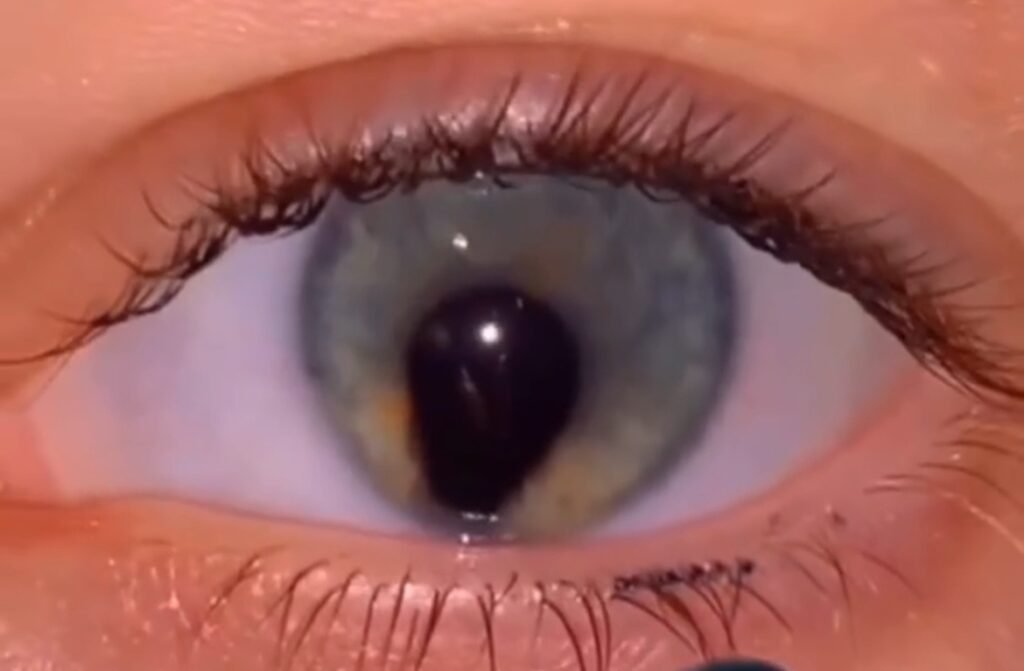
Coloboma of the Eye: Causes, Symptoms, and Treatment
What Is a Coloboma?
A coloboma is a congenital (present at birth) condition in which a portion of the eye tissue is missing. This gap can affect one or both eyes and may involve various parts, including the iris, retina, optic nerve, macula, ciliary body, or even the eyelid.
The most visible and recognizable type is the iris coloboma, which gives the pupil a distinctive keyhole or cat-eye shape.
Depending on where the coloboma occurs, it can cause mild to severe vision problems or sometimes no symptoms at all. Many people discover a coloboma during a newborn eye exam or routine ophthalmologic checkup.

Who Gets Coloboma?
Anyone can be born with a coloboma. It’s a genetic disorder, meaning it’s often inherited from one or both parents. However, having a parent with coloboma doesn’t guarantee that their child will inherit it.
This condition occurs in about 1 in every 10,000 births, but the true number may be higher because many cases go undiagnosed, especially when symptoms are mild or absent.
Coloboma is sometimes part of a larger genetic syndrome, such as CHARGE syndrome, which affects multiple systems in the body, including hearing, heart development, and facial structure.
How Does Coloboma Affect the Eye?
The impact of a coloboma depends on which part of the eye is affected:
Iris coloboma: Causes a keyhole-shaped pupil and light sensitivity. Retinal coloboma: May lead to blind spots or vision loss in certain areas. Optic nerve coloboma: Can cause significant visual impairment or blindness. Macular coloboma: Affects central vision and detailed sight. Eyelid coloboma: Results in a notch or gap in the eyelid, sometimes requiring surgical repair.
Colobomas can be unilateral (one eye) or bilateral (both eyes). Some individuals may have different types of colobomas in each eye.
Iris Coloboma: The Most Common Type
An iris coloboma affects the colored part of the eye and is often easily visible. It may appear as if the pupil is “leaking” downward into the iris, forming a keyhole-like opening. Despite its appearance, nothing is physically leaking—this shape simply reflects the missing section of iris tissue.
Does an Iris Coloboma Affect Vision?
In some cases, yes. The iris muscles control the size of the pupil to regulate how much light enters the eye. Missing tissue can interfere with this process, leading to:
Light sensitivity (photophobia) Blurry or double vision Ghost images (afterimages that linger when you move your eyes) Difficulty seeing in bright conditions
Some people experience no visual impairment at all, while others may struggle with glare or focusing in dim light.
Symptoms of Coloboma
Coloboma symptoms vary widely depending on severity and location. Common signs include:
Keyhole-shaped pupil Light sensitivity Reduced vision or partial blindness Nystagmus (involuntary eye movement) Reduced depth perception Blind spots or missing areas in vision
Children may not show visible signs of visual impairment early on, so comprehensive eye exams are vital in infancy and early childhood.
What Causes Coloboma?
Colobomas occur when the optic fissure, a gap that forms early in fetal eye development, fails to close completely. This process normally occurs around the seventh week of pregnancy. When it doesn’t seal properly, a portion of the eye tissue doesn’t form, leading to a coloboma.
Risk Factors and Genetic Links
Inherited genetic mutations affecting eye development Chromosomal abnormalities or syndromic conditions (like CHARGE syndrome) Environmental factors, including alcohol use during pregnancy, which can increase risk
Genetic testing can help identify the specific mutation or syndrome associated with the condition.
Diagnosis of Coloboma
A pediatrician or ophthalmologist can often diagnose a coloboma by examining the eyes shortly after birth. For deeper or internal colobomas (retinal or optic nerve), a dilated eye exam, optical coherence tomography (OCT), or fundus photography may be required.
Because colobomas can occur with other eye abnormalities, doctors may also check for associated conditions such as cataracts, glaucoma, or retinal detachment.
Treatment and Management
There’s no surgical treatment that can replace the missing tissue caused by a coloboma. However, several management options can improve vision or appearance:
Corrective lenses (glasses or contact lenses) Cosmetic or prosthetic contact lenses to mask the keyhole pupil Low-vision aids to enhance daily functioning Patching therapy to prevent amblyopia (“lazy eye”) Surgical repair, in rare cases, for eyelid or severe iris colobomas
Regular follow-up with an eye care specialist is essential to monitor vision changes and detect complications early.
Possible Complications
Over time, individuals with coloboma may be more prone to other ocular conditions, such as:
Cataracts Glaucoma Retinal detachment
Routine eye exams and imaging can help detect and treat these issues before they cause permanent damage.
Living with Coloboma
Most people with coloboma live full, healthy lives with proper vision management. Children benefit from early intervention, vision therapy, and adaptive learning tools to support school and daily life.
If you or your child has been diagnosed with coloboma, genetic counseling can also help determine whether other family members might be at risk or carry similar genetic traits.
Key Takeaway
Coloboma of the eye is a rare congenital condition that can affect different parts of the eye, leading to varied visual outcomes. While it can’t be reversed, modern vision aids, protective measures, and regular eye care allow most people with coloboma to maintain healthy vision and lead normal lives.
